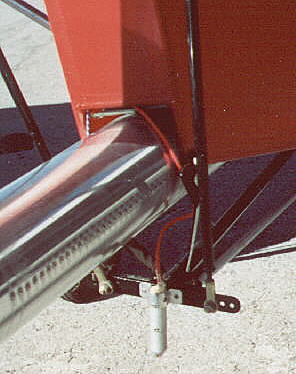|
|
 The original aileron chord was fifteen inches. Cruise aileron dynamic loading was so great that one could not displace the stick sideways. Later FireFly plans called for nine inch chord ailerons*. I built and installed new ailerons. But aileron stick forces remained much higher that elevator stick forces. To make aileron stick pressure equivalent to elevator stick pressure, I moved aileron push rod hole location in toward the center of rotation by 13/16 of an inch. This position gives a maximum of 20 degrees down aileron, and this seems to be more than enough movement.
The original aileron chord was fifteen inches. Cruise aileron dynamic loading was so great that one could not displace the stick sideways. Later FireFly plans called for nine inch chord ailerons*. I built and installed new ailerons. But aileron stick forces remained much higher that elevator stick forces. To make aileron stick pressure equivalent to elevator stick pressure, I moved aileron push rod hole location in toward the center of rotation by 13/16 of an inch. This position gives a maximum of 20 degrees down aileron, and this seems to be more than enough movement.
I consider these changes to be one of a safety issue. Before the ailerons were so heavy that one could not stay ahead of the plane in the roll axis. When flying across country through thermals, it would wear you out. After an hour you wanted to do nothing but get it on the ground. If the flight ended in a cross wind landing, you were in trouble because you did not have the energy for it. With the above changes only gentle pressure is required to maintain level flight and landing in gusty cross winds is a snap. *Current FireFly plans call for an eleven inch chord aileron. Since the above, I ran some numbers to see what the expected improvement could be. I have not measured stick pressures or roll rates. What I found is the combined mechanical pivot change and aileron chord reduction, deceased the stick load in roll by 67%. These calculations can be see at (click here). With this mechanical advantage change and by removing all mechanical play from the aileron to stick, the FireFly can be flown through rough air with little physical effort. Currently the wings can be leveled with slight pressure on the stick, and so, one seldom feels uncomfortable in thinking that the FireFly may get ahead of you in roll. |